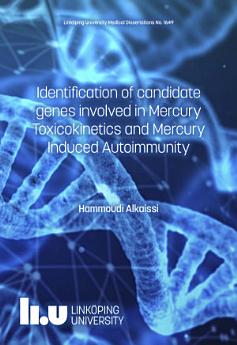Identification of candidate genes involved in Mercury Toxicokinetics and Mercury Induced Autoimmunity
About this ebook
OBJECTIVES: To find loci and candidate genes associated with phenotypes involved in the development of autoimmunity and find candidate genes involved in the regulation of renal Hg excretion.
METHODS: MHC II (H-2s) mice were paired (A.SW x B10.S) to obtain F2 offspring exposed to 2.0 or 4.0 mg Hg in drinking water for 6 weeks. Mercury induced autoimmune phenotypes were studied with immunofluorescence (anti-nucleolar antibodies (ANoA)), ELISA anti-DNP/anti-ssDNA (polyclonal B cell activation), anti-chromatin antibodies (ACA) (4.0 mg Hg), and serum IgG1 concentrations. Mercury accumulation in kidney was performed previously and data was included as phenotype. F2 mice exposed to 2.0 mg Hg were genotyped with microsatellites for genome-wide scan with Ion Pair Reverse Phase High Performance Liquid Chromatography (IP RP HPLC). F2 mice exposed to 4.0 mg Hg were genotyped with single nucleotide polymorphisms for genomewide scan with SNP&SEQ technology platform. Quantitative trait loci (QTL) was established with R/QTL. Denaturing HPLC, next generation sequencing, conserved region analysis and genetic mouse strain comparison were used for haplotyping and fine mapping on QTLs associated with Hg concentration in kidney, development of ANoA and serum IgG1 hypergammaglobulinemia. Candidate genes (Pprc1, Bank1 and Nfkb1) verified by additional QTL were further investigated by real time polymerase chain reaction. Genes involved in the intracellular signaling together with candidate genes were included for gene expression analysis.
RESULTS: F2 mice exposed to 2.0 mg Hg had low or no development of autoantibodies and showed no significant difference in polyclonal B cell activation in the B10.S and F2 strains. F2 mice exposed to 4.0 mg Hg developed autoantibodies and significantly increased IgG1 concentration and polyclonal B cell activation (anti-DNP). QTL analysis showed a logarithm of odds ratio (LOD) score between 2.9 – 4.36 on all serological phenotypes exposed to 4.0 mg Hg, and a LOD score of 5.78 on renal Hg concentration. Haplotyping and fine mapping associated the development of ANoA with Bank1 (B-cell scaffold protein with ankyrin repeats 1) and Nfkb1 (nuclear factor kappa B subunit 1). The serum IgG1 concentration was associated with a locus on chromosome 3, in which Rxfp4 (Relaxin Family Peptide/INSL5 Receptor 4) is a potential candidate gene. The renal Hg concentration was associated with Pprc1 (Peroxisome Proliferator-Activated Receptor Gamma, Co-activator-Related). Gene expression analysis revealed that the more susceptible A.SW strain expresses significantly higher levels of Nfkb1, Il6 and Tnf than the less susceptible B10.S strain. The A.SW strain expresses significantly lower levels of Pprc1 and cascade proteins than the B10.S strain. Development of ACA was associated with chromosomes 3, 6, 7 and 16 (LOD 3.1, 3.2, 3.4 and 6.8 respectively). Polyclonal B cell activation was associated with chromosome 2 with a LOD score of 2.9.
CONCLUSIONS: By implementing a GWAS on HgIA in mice, several QTLs were discovered to be associated with the development of autoantibodies, polyclonal B cell activation and hypergammaglobulinemia. This thesis plausibly supports Bank1 and Nfkb1 as key regulators for ANoA development and HgIA seems to be initiated by B cells rather than T cells. GWAS on renal mercury excretion plausibly supports Pprc1 as key regulator and it seems that this gene has a protective role against Hg.
Ratings and reviews
- Flag inappropriate

